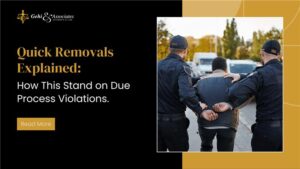
The U.S. government’s expansion of expedited removal procedures has ignited a fierce debate over due process violations and constitutional rights. While initially intended for border enforcement, expedited removals now extend to the U.S. interior. Raising concerns about systemic equity, procedural flaws, and potential rights violations. The following fundamental questions are being asked: Are we prioritizing efficiency over justice? How do these changes impact families, communities, and the core principles of fairness in our legal system?
Let’s unpack the complexities of expedited removal. Focusing on its conflicts with due process, the systemic flaws it exposes, and the human cost behind these policies. Through the lens of recent landmark cases, we can explore how this controversial expansion jeopardizes equity and justice in the immigration system. We’ll also see why having a skilled Queens immigration attorney can greatly benefit those affected.
Does the Expansion of Expedited Removal Cause Due Process Violations?
The expansion of expedited removal policies has fundamentally altered the landscape of U.S. immigration enforcement. Raising serious concerns about due process violations. Previously it was confined to individuals at the border or apprehended shortly after entry. Expedited removal now applies to noncitizens detained anywhere in the United States.
Specifically, those who cannot immediately prove they have lived in the country for over two years. This policy shift bypasses judicial oversight and legal representation, a stark departure from principles that historically upheld due process.
The History of Expedited Removal
Introduced by the Illegal Immigration Reform and Immigrant Responsibility Act of 1996 (IIRIRA). Expedited removal was initially intended as a limited tool to address immigration violations at U.S. borders. For over two decades, this process was applied to individuals seeking admission at ports of entry. It was also applied to those apprehended near the border shortly after arrival.
The policy’s original framework ensured minimal judicial safeguards. This included a credible fear interview for asylum seekers and the right to present evidence of lawful presence. However, the rule drastically expands this process to individuals anywhere in the U.S., including interior regions like Queens, New York.
Under this expanded scope, low-level immigration officers, without judicial involvement, can order removal within 24 hours. This broad application disregards the historical precedent of providing hearings before an impartial adjudicator. Creating a justice system where proximity to legal representation or evidence is irrelevant.
Between 1997 and 2004, expedited removal was applied cautiously, reflecting its inherently limited scope. By extending this policy to individuals apprehended far from the border, the rule dismisses decades of experience. This shows that due process safeguards are essential to avoiding erroneous removals.
A Case Study
A recent case illustrates the profound flaws in the expanded expedited removal system. A Queens resident and noncitizen who had lived in the U.S. for 22 months, was apprehended during an everyday activity. Attending a family gathering. Detained on the spot, she was unable to produce documentary evidence proving her continuous presence.
Despite having family ties and contributing to her community, she was summarily deported under expedited removal. Her case underscores how the expansion disproportionately targets individuals in immigrant-heavy regions like Queens. An area where many residents have limited access to legal resources or face language barriers.
Data from the case highlights how similar cases often involve immigrants apprehended during routine activities. These activities include grocery shopping or school pick-ups. Without time to gather evidence or consult an attorney, these individuals are stripped of their right to a fair review. Leaving families and communities destabilized.
Legal and Constitutional Challenges
The expansion has faced legal scrutiny for its apparent conflict with the Fifth Amendment’s due process guarantees. The plaintiffs in a recent case argue that expedited removal constitutes clear due process violations. Denying individuals the right to a meaningful hearing. It also denies them access to legal counsel and adequate time to gather evidence.
Moreover, the policy places the burden of proof entirely on the individual. Often under conditions that make it impossible to meet this standard. Immigration officers are given sweeping authority to act as judge and jury, with little accountability or oversight.
Historically, courts have emphasized the importance of due process in immigration cases. As noted in a recent complaint. The expedited removal process fails to align with constitutional requirements. Such as ensuring a neutral decision-maker and offering a reasonable opportunity to be heard.
Impact on Immigrant Communities in Queens
Queens, New York, home to over 2 million immigrants, is a model of the policy’s disproportionate impact. The borough’s diverse population, with significant numbers of noncitizens, faces heightened risks under the expansion.
This abrupt process affects individuals and erodes the trust between immigrant communities and law enforcement. Fear of detention discourages immigrants from reporting crimes, seeking medical care, or participating in civic activities.
Advocacy groups have documented and reported the deportation of individuals with strong community ties and potential legal defenses under expedited removal. Their research highlights how the lack of procedural safeguards exacerbates existing inequalities and fosters a climate of fear.
What Does the Future Hold?
The expansion of expedited removal raises critical questions about the future of immigration enforcement and due process violations in the US. As the judiciary considers challenges brought forward by recent cases, the stakes could not be higher. A decision to uphold the rule would set a troubling precedent and widen the gap in access to justice for immigrant communities.
Conversely, a judicial reversal could restore some balance, requiring the government to implement stricter safeguards and prioritize fairness over expediency. Advocates argue that reforms should include mandatory legal representation, extended timelines for evidence collection, and independent review by immigration judges.
The fight to preserve due process in expedited removal cases is not just about legal principles. It is about protecting families, communities, and the foundational values of justice and equity.
Errors in Immigration Officer Procedures Likely to Result in Mistaken Deportations
Immigration officers are the gatekeepers of expedited removal proceedings, yet their procedures are alarmingly prone to error. Often resulting in due process violations. These lapses stem from systemic flaws, including insufficient training, procedural oversights, and a lack of checks and balances.
As revealed in a recent case, these errors have led to wrongful deportations of both eligible asylum seekers and individuals with lawful status.
Procedural Flaws in Documentation
Documentation errors are among the most pervasive and dangerous issues in expedited removal processes. Immigration officers are responsible for recording critical information about detainees. However, these records are often riddled with inaccuracies.
For example, the 2005 USCIRF Study, documented numerous instances where sworn statements by noncitizens were misrepresented or mistranslated. In many cases, officers failed to provide accurate translations of questions. Leading to responses that did not reflect the individual’s intent or situation.
Further, statements written in English were presented to non-English-speaking detainees for signatures without translation. This practice denies individuals the opportunity to confirm or contest critical details about their cases.
Alarmingly, officers frequently skip mandatory steps, such as verifying claims of continuous presence. A recent case exemplified this issue, despite residing in the U.S. for nearly two years. The plaintiff’s inability to immediately provide proof of continuous presence led to an expedited removal order. A decision based on incomplete and inaccurate documentation.
Coercive Practices
Coercion is another troubling trend in expedited removal processes. Noncitizens report being pressured into signing removal orders under duress or misinformation. A recent case highlights scenarios where individuals were threatened with prolonged detention or misled about their rights. Forcing them to waive claims for relief or asylum applications.
In some instances, officers have been accused of intimidating detainees into abandoning their asylum claims altogether. For example, they have falsely informed asylum seekers that pursuing their claims would result in indefinite detention or unfavorable outcomes. The 2016 USCIRF Study also detailed cases where officers exhibited hostility toward asylum seekers. Undermining their credibility and discouraging them from asserting valid fears of persecution.
Failure to Recognize Evidence of Eligibility
The burden of proof in expedited removal disproportionately impacts noncitizens unable to immediately produce documentation. Raising serious concerns about due process violations. Even when they have valid claims to remain in the U.S. this creates systemic inequities. Especially since many individuals lack access to their homes, families, or legal representatives while detained.
This issue was evident in a recent case where the plaintiff had community ties and a pending asylum application. Her expedited removal illustrates how officers frequently overlook or dismiss critical evidence of eligibility, focusing instead on procedural expediency. Reports also indicate that individuals with credible claims are often summarily removed. Without their cases being referred to asylum officers for credible fear interviews.
Inadequate Oversight and Quality Assurance
While regulations mandate supervisory review of expedited removal orders, this safeguard is often superficial. Supervisors typically review only the paperwork completed by officers. Thus, failing to verify the accuracy of the recorded information or to corroborate the detainee’s claims.
The 2005 and 2016 USCIRF Studies emphasize the lack of robust quality assurance mechanisms. Asylum officers reviewing expedited removal cases have reported finding glaring errors in documentation. This includes contradictory statements and boilerplate language that fails to reflect the unique circumstances of individual cases. Such lapses exacerbate the risk of erroneous deportations.
Precedents for Change
Legal challenges are essential to addressing these procedural deficiencies. A recent case showed the need for more stringent oversight and accountability in expedited removal proceedings. It highlighted the flaws in documentation practices, coercive tactics, and oversight gaps. Litigation forces the government to confront the systemic issues undermining due process.
For individuals impacted by these errors, consulting an experienced Queens immigration attorney is crucial. These professionals can identify procedural violations, gather evidence to support claims and advocate for fair treatment.
The issues with the Burden of Proof in Expedited Removals
Immigrants are often detained without warning and expected to prove continuous presence in the U.S. for two years. However, as detailed in a recent case this expectation fails to account for real-world challenges and highlights glaring due process violations.
Unrealistic Expectations
The expedited removal rule assumes that noncitizens can provide proof of their continuous presence in the U.S. at a moment’s notice. In the form of rent receipts, employment records, or medical bills. Yet, this assumption is wildly detached from the realities of daily life.
Barriers to Legal Representation
The expedited removal process deliberately truncates the timeline for contesting deportation, effectively barring individuals from accessing legal counsel. Unlike Section 240 removal proceedings, where immigrants are afforded the opportunity to obtain legal representation and present evidence.
Poverty and Removal Risks
A recent case file highlights that noncitizens living paycheck to paycheck or working multiple informal jobs are disproportionately targeted. These individuals are less likely to have consistent housing or steady employment.
Take Action to Protect Your Rights in the Face of Expedited Removal
Expedited removal may be swift, but its consequences are devastating and often irreversible. Families are torn apart, communities are left in fear, and countless individuals face deportation. Often without a meaningful chance to defend themselves. As seen in a recent case, this policy expansion causes due process violations. Leaving vulnerable populations without the protection they deserve.
You don’t have to face this battle alone. If you or someone you know is caught in the maze of expedited removal, contact a Queens immigration attorney today. Our attorneys understand immigration law and are dedicated to fighting for your rights. Book a free consultation Today now!




